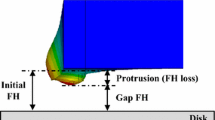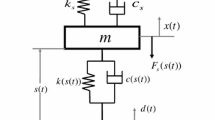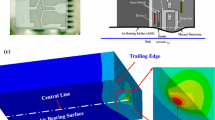Abstract
To achieve lower flying height for high areal recording density, the laser zone texturing of the disk needs to be designed to reduce glide height. One problem of the laser bump design is that the regular laser bump pattern often produces glide resonance phenomenon, which leads to failure of the glide height test. However, it was found in this study that glide resonance is an intrinsic problem of the glide head used and resonance phenomenon depends on the type of the head slider, that is, the natural frequency of the slider body. Therefore, higher glide height or glide failure caused by glide resonance does not lead to head/media interface problem in the real drive operating conditions in which the data head is used. Pseudo- random bump pattern greatly reduces the glide resonance. Smaller bump pitch will also help to reduce the glide resonance. However, as bump spacing becomes smaller, glide height will be increased due to increased air pressure developed around the bumps. Lowering bump height is the most effect way to reduce glide avalanche.
Similar content being viewed by others
References
Chen H., Yu, T., Su, M., Chen, Yi, Yong, P. and Lee, J. K., 1997, “Glide Characteristics of a Laser Textured Disk,”IEEE Trans. Magnetics, Vol. 33, No. 5, pp. 3103–3105.
Clark, B. K., 1991, “An Experimental Correlation of Slider-Disk Contact Detection between Piezoelectric and Electrical Resistance Measurements,”IEEE Trans. Magnetics, Vol. 27, No. 6, pp. 5151–5153.
Hu, Y. and Bogy, D., 1997, “Effects of Laser Textured Disk Surfaces on a Slider’s Flying Characteristics,”ASME J. of Tribology, 97-TRIB-18.
Hu, Y. and Bogy, D., 1997, “Flying Characteristics of a Slider over Textured Surface Disks,”IEEE Trans. Magnetics, Vol. 33, No. 5, pp. 3196–3198.
Knigge, B. and Talke, F. E., 1999, “Acoustic Emission and Stiction Analysis of Patterned Laser Textured Media,”IEEE Trans. Magnetics, Vol. 35, No. 2, pp. 921–926.
Kuo, D, Gui, J., Marchon, B., Lee, S., Boszormenyi, I., Liu, J. J., Rauch, G. C. and Vierk, S., 1996, “Design of Laser Zone Texture for Low Glide Media,”IEEE Trans. Magnetics, Vol. 32, No. 5, pp. 3753–3758.
Marchon, B., Kuo, D., Lee, S., Gui, J. and Rauch, G. C., 1996, “Glide Avalanche Prediction From Surface Topography,”ASME J. Tribology, Vol. 118, pp. 644–650.
Yao, W. H., Kuo, D., Ku, R. and Marchon, B., 1998, “Head-Disc Dynamics of Low Resonances Laser Textures-A Spectrogram Analysis,”IEEE Trans. Magnetics, Vol. 34, No. 4, pp. 1699–1701.
Author information
Authors and Affiliations
Corresponding author
Rights and permissions
About this article
Cite this article
Choa, SH., Wang, G. Resonance phenomenon and its effects of laser texture disk. KSME International Journal 14, 744–751 (2000). https://doi.org/10.1007/BF03184460
Received:
Revised:
Issue Date:
DOI: https://doi.org/10.1007/BF03184460




